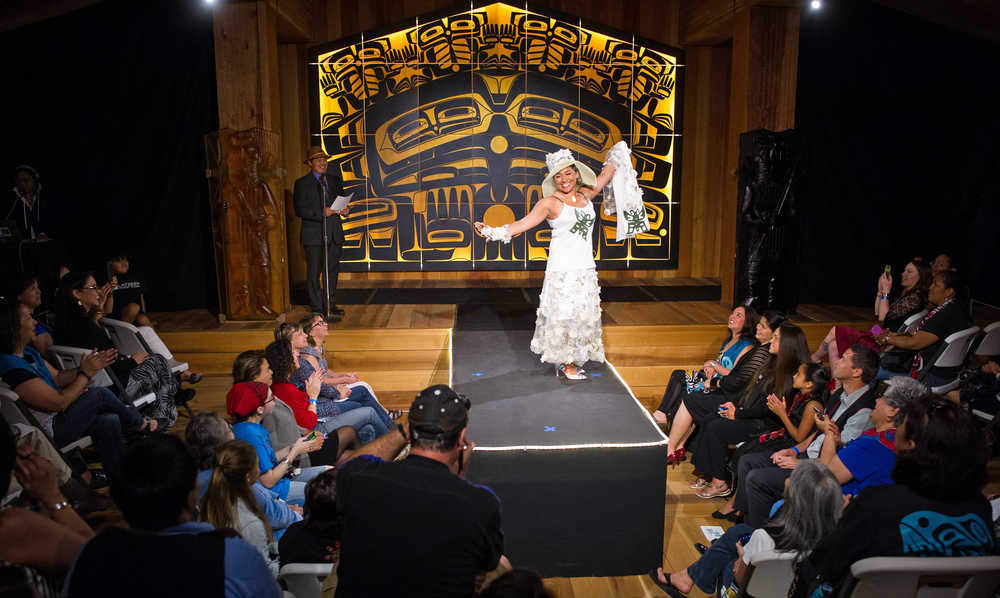A few things set Juneau’s first ever Celebration fashion show apart from ones often seen in media: the host spoke in Tlingit, a Native dancer opened the show and designs had history woven into their fabrics.
But one thing was the same — the clothes were incredible.
Sleek lines on gowns, shimmering fabrics and runway poses wowed the small crowd in the sold out venue, the Shuká Hít (clan house) in the Walter Soboleff Building on Friday evening. Garments, jewelry and body art by 18 Native designers were on display by models who did much more than just walk down the runway.
Model Chris Bryant took the stage with apparel by internationally acclaimed Haida designer Dorothy Grant, whose work was recently seen on the Oscars red carpet by actor Duane E. Howard. Bryant posed in Native dance positions while wearing modern business attire — black pants with a white button up — accented with an indigenous-inspired vest.
It was a seemingly simple way of incorporating Native style into mainstream life, said Sealaska Vice Chair Jackie Pata.
“Not only is our culture special to us when we come to Celebration or when we put on our special regalia during ceremonies, but . . . we are Tlingit, Haida and Tsimshian every day,” she said.
Work by Pata was also featured Friday night — a school uniform modeled by the young Hannah Watts was a crowd favorite. Watts’ uniform, complete with skin-stitched trimmings and buttons with the Raven moiety, was designed to take her “from classroom to dance practice,” said Lance Twitchell, the night’s emcee. The outfit was inspired by what the designer wishes children in boarding schools would have been allowed to wear back when Native culture was forced out of the classroom.
Other styles also told stories, such as Kwakiutl and Squamish designer Pam Baker’s “New Eagle” dress modeled by Brittinie Read. The black and white garment was crafted in a way to model an Eagle flying, telling the story of the bird that flies closest to its creator. Read “flew” down the runway in the dress with white feathers in her hair, motioning her arms as if taking flight.
Emcee Twitchell told the crowd that although all the design elements and the hard work behind them should be celebrated, what was most important that evening was the audience takeaway.
“One of the really important elements is you and your reaction to what you’re seeing,” he said. “Even in the smallest event, we lift each other up and it just becomes contagious.”
Notable Tlingit weaver Clarissa Rizal was among Friday’s fashion show guests. She spoke afterward to the importance of lifting others through art. She was able to see work by her daughter Lily Hope and her sister Deanna Lampe displayed, and other pieces modeled by another daughter Ursala Rose. It was a family affair in many ways — for her immediate loved ones and for the tribe — and that’s what she said matters most in the end.
“It’s a celebration of one another,” Rizal said. “When you please the Native community, when you please your own people, then you know you’ve done well.”
Rizal went on to say that the fashion seen Friday night has the power to inspire Native and non-Native artists alike, and what was seen in the Shuká Hít was “just the beginning” of a Native couture expansion.
Guest Miranda Belarde-Lewis, a professor and curator visiting from Seattle, summarized the evening’s show as “stunning,” and something Natives and non-Natives can all get excited about.
A Tlingit and Zuni Native herself, she said she wears Native jewelry in her daily life because she is Native every day. She also said she’s happy to see couture hit Juneau’s Celebration scene for the first time because fashion has the ability to shift minds.
“If you can learn a little bit about a Native culture by a scarf or jewelry or a design in clothing, then hopefully that sparks awareness and compassion and a recognition of our humanity,” Belarde-Lewis said. “There are people behind these designs.”
• Contact reporter Paula Ann Solis at 523-2272 or paula.solis@juneauempire.com.

